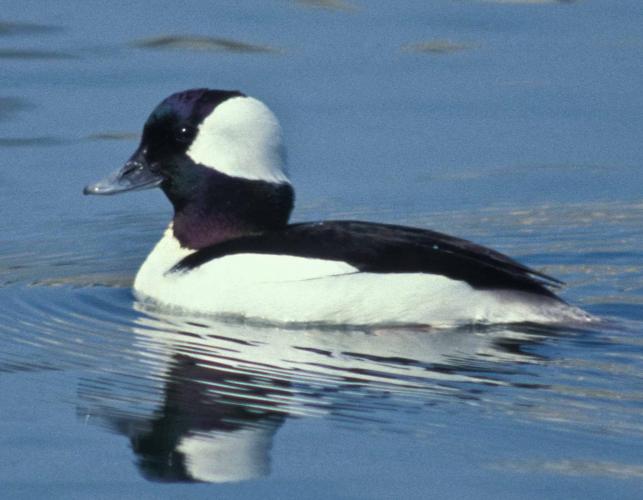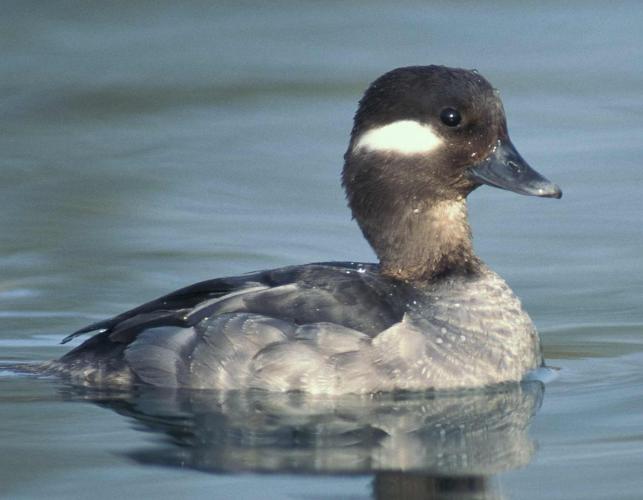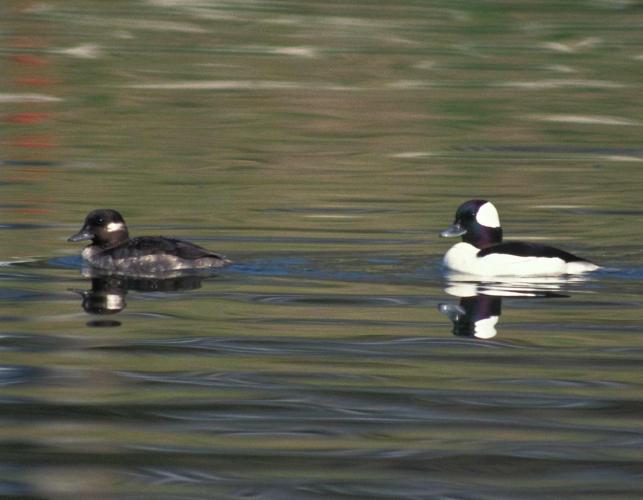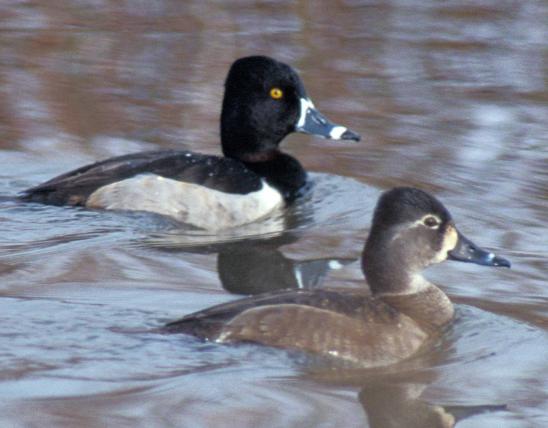
Buffleheads are small, compact ducks with large, rounded heads. They bob lightly in the water, then, in a flash, dive below the surface. The male has a black back and puffy black head with a white patch behind the eye. The female is brown with a white belly, white speculum, and white, oval cheek patch. Usually silent.
This duck dives underwater quickly, and it is a fast flyer with rapid wingbeats. Unlike other sea ducks, the bufflehead can take off like a dabbler and does not have to run far on the surface of the water to gain speed before takeoff. They are rarely seen walking on land.
Similar species: Common goldeneye and Barrow’s goldeneye males have a different pattern on their dark heads: both have a white patch between bill and eye (not on the back of the head). The hooded merganser breeding male has a long, thin bill, and its sides are reddish brown. The ruddy duck male’s body is reddish brown, and its long, stiff, upright tail is distinctive.
Length: 14 inches.

Statewide; in winter, numbers are greater in southern Missouri.
Habitat and Conservation
In spring and fall, migrating buffleheads are seen on marshes, lakes, and rivers in deep water. In winter, they commonly occur on unfrozen deepwater lakes and rivers. Buffleheads and goldeneyes are in a group of waterfowl called sea ducks and are usually found on open water. Their legs are very short and far to the rear of their small-winged body, making it difficult for them to stand on land. They dive in deep water, frequently searching for snails and crustaceans on the bottom.
Food
Buffleheads forage on marshes, lakes, and rivers in deep water for a wide variety of aquatic invertebrates, including insect larvae and snails, as well as small fish and the seeds of pondweeds, naiads, and bulrushes.
Status
Uncommon migrant; rare winter resident. In the early 20th century, bufflehead populations were decreasing so rapidly from overhunting that conservationists worried it would go extinct. Laws protecting migrating birds allowed the bufflehead’s populations to return to safe levels, and duck hunting is now carefully managed to protect this species.
Life Cycle
Numbers peak from March through mid-April, and again in November. In late winter and early spring, courting males bob and wave their heads, showing off their erected fluffy head feathers. Breeding range comprises much of central Canada and parts of Alaska. Buffleheads are monogamous and remain with the same mate for several years. They nest in tree cavities, relying mostly on holes originally excavated by northern flickers and pileated woodpeckers. They also nest in human-build nest boxes. Clutches comprise 4–17 eggs, which are incubated for about a month. The young leave the nest within a few days of hatching. They are able to take flight about 50 days after hatching. A bufflehead can live to be at least 18 years old.
Human Connections
Unrestricted hunting caused drastic declines of this species a hundred years ago, but conservation laws helped the species recover. Today, clear-cut logging of boreal forest and loss of aspen forestland to agricultural development decreases the nesting habitat for this species.
Ecosystem Connections
These ducks help control the populations of the many small aquatic animals and plants they eat. Based on fossil evidence, it appears the bufflehead has existed for at least 500,000 and perhaps even 2 million years.













About 350 species of birds are likely to be seen in Missouri, though nearly 400 have been recorded within our borders. Most people know a bird when they see one — it has feathers, wings, and a bill. Birds are warm-blooded, and most species can fly. Many migrate hundreds or thousands of miles. Birds lay hard-shelled eggs (often in a nest), and the parents care for the young. Many communicate with songs and calls.

























